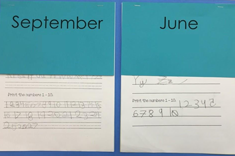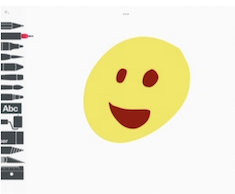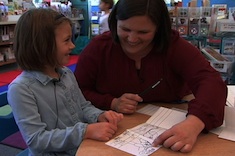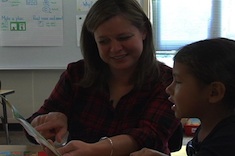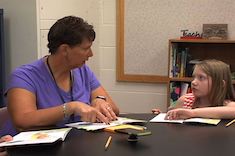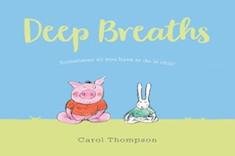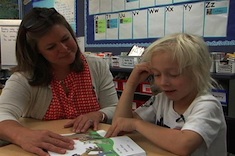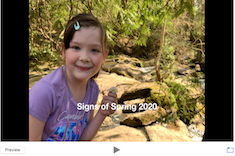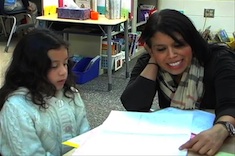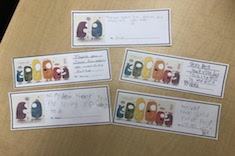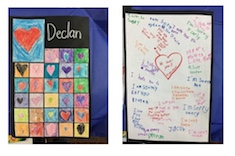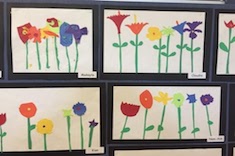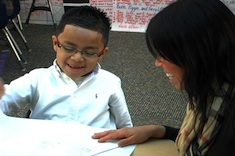1st
Latest Content
Mother Language Day and Tradition Presentations
Bitsy Parks shares special events that help students widen their scope of acceptance and appreciation for the differences among us.
Finding a Way to Make Heterogeneous Grouping a Reality
Tammy Mulligan shares the vulnerable process of forming heterogeneous groups for book discussions.
A Complete Circle: Identity, Growth, and Community
Bitsy Parks offers key end-of-the year activities that allow students to reflect and notice their identities, growth, and community as readers and writers.
Importance of Talk in Writing Workshop
Julie Johnson reminds us of important mindsets to adopt to allow students the space and permission to talk while composing. When students talk as writers, they have opportunities to create new understandings, build relationships, and validate each other.
Writing Work Plans
Brian Sepe empowers students to make their own plans during writing workshop.
First-Grade Writing Conference: Beginnings, Middles, and Ends
In this first-grade writing conference, Katrina Edwards helps Brooklyn order and stretch out her writing with a beginning, middle, and end. She uses long pages and scissors as tools.
Assessing Students Online: Small and Powerful Moves
Tammy Mulligan shares small and mighty moves when assessing students online.
Guided Reading in a First-Grade Group
Melissa Atwood leads a first-grade guided reading group. This is the second video in a two-part series.
Small-Group Instruction: Bookmaking
Brian Sepe shares one of his favorite activities for small groups of young learners: making books together.
Book Series Joy
Bitsy Parks shares the way a series study enriches the reading lives of students and serves as an intervention to help readers grow.
Guided Reading in First Grade: Blends
Melissa Atwood leads a first-grade guided reading group. The focus at the start of the lesson is on blends in words. This is the first video in a two-part series.
First-Grade Reading Conference: Coaxing and Supporting
Bitsy Parks helps first grader Sophia tackle the tough job of making meaning and decoding words early in the year with lots of encouragement and good humor.
Guided Reading Part 1: Previewing and Skills
This is the first guided reading group in September for Cheryl Miller. She begins the lesson by previewing the book and reminding students of the skills they are working on. This is the first video in a three-part series.
Picture Books for Mental Wellness
Mandy Robek learns a lot about worry from her daughter, and discovers a treasure trove of picture books to promote mental wellness and help students cope with difficult emotions.
Using Pictures to Decode in First Grade
Bitsy Parks helps first grader Zac work on his decoding skills by using a fun picture book.
Using Photographs in Remote Learning Communities
Bitsy Parks shares how she and her first-grade students used photography to bridge the distance between home and school this spring, learning lessons she is using this fall in remote learning contexts.
First-Grade Conference: Information Writing
Stella Villalba confers with Esmeralda about her information writing on blue jays.
Letting Students Organize Informational Books
Mandy Robek is a little nervous about setting her students loose to organize informational texts, but she couldn’t be more pleased by what they learn in the process.
Routines for Building Gratitude
Bitsy Parks finds even the dreariest days in her first-grade classroom are infinitely more enjoyable because she’s built in routines for expressing gratitude.
First Grade Minilesson: Connections
Melissa Atwood leads her first-grade class with a minilesson early in the school year on making connections to text.
First-Grade Conference: Repeated Phrases in Writing
Bitsy Parks confers with Michael about his gingerbread man writing. She encourages him to use a repeated phrase in the writing, echoing a whole-class lesson on repeated phrases.
Out of Sight, Out of Mind: Accountability for Young Writers
Stella Villalba teaches young writers about writer’s craft. So how come evidence of learning from the minilessons isn’t showing up when she confers with her students? She decides to develop a plan to help students link craft lessons with their writing.
Navigating the Interpretation Process
Tammy Mulligan shares how she introduces students to the process of interpreting literature at different grade and developmental levels.
First-Grade Writing Share: Highlighting Craft
Bitsy Parks leads a writing share early in the year, presenting three student examples of writing and highlighting different aspects of writer’s craft linked to minilessons.
Everyday Celebrations and Traditions
Bitsy Parks shares how she builds a learning community with displays and traditions that celebrate families.
Second-Grade Conference: Illustrations and Frames
Ruth Ayres confers with second grader Reagan about writing she is revising for publication about a class trip to the zoo that included her grandmother. Ruth introduces her to the concept of frames in illustrations, using an example from a picture book.
Reassuring Worried Children with Picture Books
Mandy Robek learns a lot about worry from her daughter, and at the same time discovers a treasure trove of children’s books to help students overcome worries.
The Power of Teaching Journals
Bitsy Parks finds inspiration for her teaching journal in the work of Debbie Miller. She explains how she uses her journal daily, and how it has evolved over time.
Planting Rainbows
Bitsy Parks shares how she adapts her favorite first-grade spring literacy project for remote learning.
First Grade ELL Conference: Writing and Pop Culture
Stella Villalba confers with first grade English language learner Eric about his writing on angry birds, with Esmeralda also sharing advice.
Browse Content By
Type
Category
- Assessment Tools
- Big Fresh Archives
- Booklists
- Choice Numeracy
- Classroom Design
- Common Core
- Community Building
- Conferring
- Content Literacy
- Digital Literacy
- English Language Learners
- Equity
- Family Relations
- Free Samples
- Guiding Groups
- Leadership
- Literacy Coaches
- Mentor Texts
- Minilessons
- New Teacher Mentors
- Podcasts
- Poetry
- Quote Collections
- Reading Strategies
- Self Care
- Struggling and Striving Learners
- Talking and Listening
- Teacher Study Groups
- Teaching Reading
- Teaching Writing
- Word Study and Vocabulary
Author
- Melissa Quimby
- Nawal Qarooni
- Gwen Blumberg
- Julie Cox
- The Lead Learners
- Hannah Tills
- Josie Stewart
- Ruth Metcalfe
- Mallory Messenger
- Becca Burk
- Jodie Bailey
- Vivian Chen
- Mary Brower
- Tiffany Abbott Fuller
- Stephanie Affinito
- Ruth Ayres
- Leigh Anne Eck
- Heather Fisher
- Shari Frost
- Julie Johnson
- Suzy Kaback
- Gigi McAllister
- Shirl McPhillips
- Melanie Meehan
- Cathy Mere
- Debbie Miller
- Tara Barnett and Kate Mills
- Tammy Mulligan
- Dana Murphy
- Bitsy Parks
- David Pittman
- Brenda Power
- Heather Rader
- Matt Renwick
- Mandy Robek
- Christy Rush-Levine
- Gretchen Schroeder
- Jen Schwanke
- Brian Sepe
- Katherine Sokolowski
- Stella Villalba
- Jennifer Vincent
Grade Level
Choice Literacy Membership
Articles
Get full access to all Choice Literacy article content
Videos
Get full access to all Choice Literacy video content
Courses
Access Choice Literacy course curriculum and training



